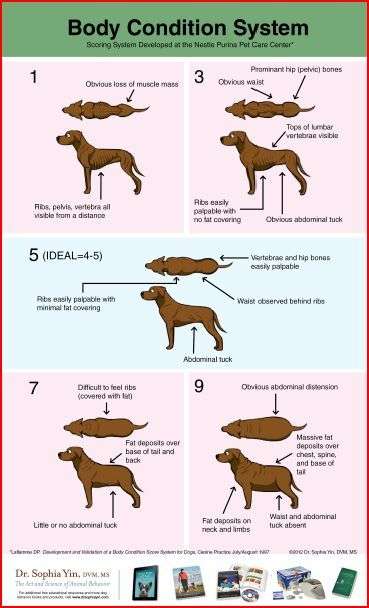Does your dog have the ideal body shape (condition)?
If not, then you are probably not feeding your dog the right amount of food.
Here’s how to determine the correct amount of food to feed your dog.

Step 1 – Determine your dogs’ Body Condition and Calorie Requirement
If your dog has Ideal Body Condition:
For young 1-2 year old active spayed or neutered dog – use Column 1
For young 1-2 year old active intact dog – use Column 2
For highly active dogs of any age – use Column 2
For the average inactive spayed or neutered dog – use Column 4
For the inactive senior dog – use Column 4
If your dog is overweight or obese (Body Condition 7-9):
For mildly overweight, use row of ideal body weight instead of their actual weight – use Column 4
For overweight or obese prone dog – use Column 3
For obese dog – use Column 5
If your dog is underweight (Body Condition 1-3):
For mildly underweight dog – use Column 2
For severely underweight dog, use row of ideal body weight instead of their actual weight – use Column 6
Step 2 – Determine the number of calories in a cup of your dogs’ food
Look on the dog food bag. Look for Guaranteed Analysis and Calorie Content. There should be a line that reads “Metabolizeable Energy (ME)” and values for kcal/kg and kcal/cup. Get the value for kcal/cup.
Step 3 – Calculate the appropriate amount of food to feed your dog
Calculate the amount of cups to feed your dog by dividing the number of calories required (column) by the number of kcal/cup.
e.g. Calorie requirements for an average neutered 28lb dog with ideal body condition, under column 4, is 659. The bag of dog food has 370 kcal/cup. Amount to feed is calculated as 659/370=1.78 cups.
Notes:
1- Ideal Body Weight – Using your dogs’ “Ideal Body Weight” is more accurate for determining calorie requirements than their actual weight. Does your dog have an ideal weight? Does their breed have an ideal weight? Has your Vet given you a target ideal weight? If so, use that to calculate calorie requirements.
2- If you are using treats to train your dog on a regular basic, reduce the amount of calories to determine the amount of dog food to feed. It is recommended that treats only make up 10% of your dogs diet. However, if you are currently in a dog training program and giving more than the equivalent of 10% of their diet. Then use high quality dog food instead of regular training treats. (e.g. Nulo freeze dried food or Ziwi Peak air dried raw food). Then estimate how many calories are in the treats you are using. Subtract that amount from the total amount of required calories. Now use that new value for calorie requirements to calculate the amount of dog food to feed daily.
3- Calorie Requirement Chart – these value are calculated based on Resting Energy Requirements (RER). Most dog food feeding guidelines are based on column 2 RER which is for intact active dogs. Here’s the full chart.
The calories for an intact active dog are roughly 11% more than a spayed or neutered dog. And they are 28% higher than what’s required for the average neutered house dog that gets less than 3 hours of activity per day (column 4). This means that the feeding guidelines on most, if not all, bags of dog food is too high.
4- Body Condition System Chart – there are several versions of this chart. I’m using the one created by Dr. Sophia Yin. The most popular one was originally created by Purina. If your dog has an unusual body type, you may be able to find a chart specific to your dogs breed.

Cyndi Smasal, CPDT-KA
Certified Professional Dog Trainer / Integrative Pet Specialist
Author, Pet Nutrition Specialist and Pet Care/Health Coach
About Cyndi Smasal
Cyndi is the founder and Chief Dog Lover of Pawtastic Pet Solutions.
She is a Certified Professional Dog Trainer (CPDT-KA) and has been doing in-home dog training since 2016.
Cyndi has a broad set of skills, knowledge and experience spanning two decades. She calls herself an Integrative Pet Specialist. Prior to being a dog trainer, Cyndi authored two books, studied canine nutrition and natural pet care.
For the past 18 years, Cyndi has turned her love of one dog, Norman (the subject of her first book), into a passion for all dogs. She’s helped thousands of pet parents through her books and hundreds have consulted with her about their own dogs.



